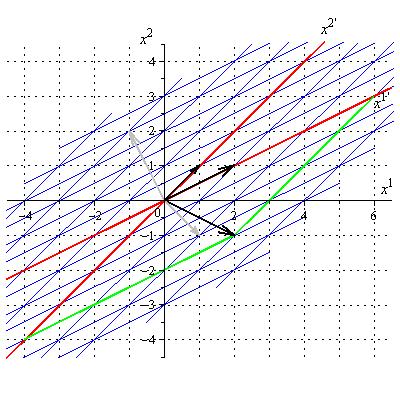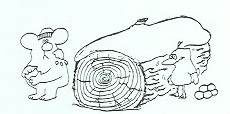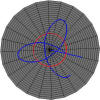MAT5600 08S homework and daily class log
Your homework will appear here each day as it is assigned, with occasional
links to some MAPLE worksheets when helpful to illustrate some points where
technology can be useful. [There are 42 class days in the semester, numbered consecutively below and labeled
by the (first initial of the) day of the week.
Monday, January 14 thru May ?.]It is your responsibility to check it here. You are responsible for any hyperlinked
material here as well as requesting any handouts or returned tests or quizzes from classes
you missed. Homework is understood to be done by the
next class meeting (unless that class is a test, in which case the homework
is due the following class meeting).

- W: GETTING STARTED STUFF. By Friday,
January 18, e-mail me [robert.jantzen@villanova.edu]
from your OFFICIAL Villanova e-mail account (which identifies you with your
full name) with the subject heading "[MAT5600]", telling about your last math courses, your comfort level with graphing
calculators (can you do symbolic derivatives and integrals on your graphing
calculator if not in Maple?) and computers and math itself, how much experience you have with MAPLE (and Mathcad if appropriate) so far, why you chose your major, etc.
[In ALL email to me, include the string "mat5600" somewhere in the
subject heading if you want me to read it. I filter my email.]
In class:
1) log on to your computer and open
Internet Explorer.
(IE allows you to open Maple files linked to web pages automatically if MAPLE is already open or if it
is available through the Start Menu Program listing under Math Applications,
otherwise use the "File Menu" "Open URL" feature to open a worksheet on the
web.)
2)
log on to the Villanova home page
in Internet Explorer (click
on the upper right "login" icon and use your standard VU email username and
password) and check out our My Courses classroom site, and visit the link to
my course homepage from it
[
http://www.homepage.villanova.edu/robert.jantzen/courses/mat5600/ ],
3)
Open Maple 11 Standard (red not yellow icon) from the Start Menu Program
listing under Math Applications
[or click on this maple file link:
oneforms.mw]
4) bob will quickly show you the computer environment supporting
our class. And chat up a bit the course.
Afterclass:
5)
log on to MyWebCT and look at the Grade book: you
will find all your Test and Maple grades here during the semester.
[This is the only part of WebCT we will use this semester.]
Check out the on-line links describing aspects of the course (no need yet to look at the
MAPLE stuff). Fill out your
paper
schedule form (get a copy in class to fill out or print it out
back-to-back earlier
to fill out in advance and bring to your first class already done)
to return in class Wednesday.
[You can
drop by my office St Aug 370 (third floor, Mendel side, by
side stairwell) to talk with me about the course if you
wish and to see where you can find me in the future when you need to.]
6) Make sure you can access and open Maple 11 Standard in citrixweb
on your laptop. If you have any trouble, email me with an explanation of the
errors. If I receive no email, it means that you were successful.
You are expected to be able to use Maple on your laptop or in class when
needed.
7) Read computer classroom etiquette.
Then read the first paper
handout: algebra/calc background
sheet.
Actual HW: Read the preface
and introduction to bob's book. And the open the worksheet
oneforms.mw and read that (Use
the "File Menu" "Open URL" option of Maple on your laptop). Also find your
old calculus book and read the section on hyperbolic functions (Stewart 5e,
section 3.9).
Citrixweb is down Tuesday evening, so here is the
HTML export of the worksheet which does
not allow you to rotate the 3D plots but you can do that later.
Brief talk about index positioning on vectors and linear function
coefficients and the dot product and linearity.
- W: return your
schedule forms at the beginning of
class [did you use the 3 letter
dorm abbreviations?];
Read pp 105-109 Flow lines of vector fields from
bob's book. [Use the
View Menu, Go To, Page in Adobe.] Do the exercise there. [Some
recalling of details if you get stuck, and a new review of hyperbolic
functions (appendix C of bob's book) and the hyperbolic geometry they
determine,] And for a field plot or directionfield, see this easily
changed example.]
Following up the HW reading, bob reviewed linear functions in the plane and
the geometry of addition of covectors and then rambled a bit about the
contents of the reading for the next day on DEwLinAlg topic of solving a
linear homogeneous system constant coefficient DEs, pushing it past the
eigenvector technique to show how the result is just the matrix exponential,
using rotations in the plane as an explicit example without doing the
eigenvector details. Hopefully by reading and working the HW problem (which
is basically solved in the PDF link), it will become clearer.
- F: Ask questions...
Read sections 1.1, 1.2 of bob's book on a vector space and its dual space. Do the one problem in section 1.2.1. Also I will add a final part to the hyperbolic
appendix with some problems for you to do (almost done except for two
illustrations).
WEEK 2[-1]:
- W: If our discussion in class allows, we move on to
read section 1.3 on the linear transformations of a vector space and
tensors which builds on 1.2 (finish that section by doing
Exercise 1.2.2). [For the direction field for the
hyperbolas see
resources/maple/fieldplotex2.mw.
Note Wikipedia has interesting
entries for many of the terms we are encountering, like the
dual space. An inner
product is called a
quadratic form in the old language (more precisely it determines an
associated symmetric form which corresponds to the inner product) while a
linear (homogeneous)
function is called a
linear form in
the old language, so sometimes I will refer to a covector as a 1-form, for
first degree form, i.e., linear form.
- F: Exercise 1.2.2 [by hand,
maple];
course info sheet, bob's cell; go
back and consider new exercise 1.3.1 on the quadruple scalar product;
read 1.4 on changing the basis and dual basis.

Week 3[-1]:
- M: start 1.5 on inner products. We will
take a few days on this one. Do the problem on the Gram-Schmidt orthogonalization
procedure below.
An inner product is just a
symmetric bilinear function of a pair of vectors from a vector space and
hence can be identified with a symmetric matrix with respect to a given
basis. If it is nondegenerate (i.e., nonzero determinant) then a simple
orthogonalization procedure ([Wiki],
called Gram-Schmidt [Wiki:
see the explicitly worked 2-dimensional example]
can be used to take any ordered basis and create from it an orthonormal
basis of mutually orthogonal unit vectors. This automatically not only
diagonalizes the matrix of components, but results in diagonal values which
have absolute value 1. The number of negative and positive signs is always
the same because it is uniquely associated with the signs of the eigenvalues
of the matrix. A positive-definite (negative-definite) inner product has all
positive (negative) signs, an indefinite one has a mix of signs. We
usually deal only with the positive-definite dot inner product on Rn.
Apply Gram-Schmidt to the columns of the upper triangular matrix whose
entries are all 1s: G = <<1,0,0>|<1,1>|<1,1,1>> in the order from left to
right or from right to left (you get two different results). This is now
problem 1.5.3, which has more parts to it. and 1.5.4. Not to mention the
already present 1.5.1-2.
- W: Continue reading 1.5 on inner products. Work on
the problems.
- F: Finish up 1.5, just reading but not doing the long
final Exercise 1.5.8. The geometric interpretation of an inner product is
cute but not necessary so don't waste too much time on that section. In
class we discussed the Gram-Schmidt diagonalization problem, and the second
derivative problem with the elliptic paraboloid.
Begin reading 2.1 and 2.2 through exercise 2.2.2.
WEEK 4[-1]:
- M: We discussed the tensor transformation law problem
from 1.4, and then based on the area of a parallelogram in the plane and the
volume of a parallelepiped in space, motivated the information contained in
the determinant function thought of as a tensor on Rn accepting n
vector inputs. For a set of n vectors, it contains 1) the volume of
the n-parallelepiped they form [absolute value], 2) orientation
(ordering) information [sign]. Evaluating the determinant on p less
than n vectors leaving some slots free contains information about
those p vectors: 1) volume of the p-parallelepiped they form,
2) "inner orientation" (ordering), 3) orientation (direction), namely how
the p-parallelepiped is directed in the n-space. The permutation
group is behind the definition of the determinant. We need some better
notation to handle it as a tensor with our index conventions.
Finish reading 2.1,2.2 and do the problems, and when ready move on to 2.3.
[I broke off part of 2.2 to become the new 2.3].
- W: We will discuss the elliptic paraboloid curvature
problem
1.5.4 last two parts, and the problems from 2.2, 2.3.
Please stop by to find my office in the next two weeks. Say hi.
Read the short section 2.4 and move on to the review so far, chapter 3. Make
sure you did or can do all problems so far.
- F: What did we do today?
WEEK 5[-1]:
- M: bob started by discussing the 3-dimensional vector space of 3x3
antisymmetric matrices, introducing a natural basis of this space and then
of its dual space, and the identity tensor etc, and then showed how the 2
pair indexed Kronecker delta was really just that identity tensor expressed
in terms of pairs of indices with respect to the original vector space R^3
above which the matrices can be interpreted as the components of second rank
tensors. with the example of projecting a vector in R^3 into its piece along
a plane subspace and its piece orthogonal to the plane along the line
subspace by subtracting away the projection in the orthogonal direction. The
projection operation acts as the identity on each subspace, since projecting
something already in a subspace does nothing. Working instead with the
9-dimensional vector space of all 3x3 matrices, we can project out the
3-dimensional subspace of antisymmetric matrices and the 6-dimensional
subspace of symmetric matrices in a similar way. Again from this point of
view the 2 pair indexed Kronecker delta just projects out the antisymmetric
part and then acts as the identity on tensors which are already
antisymmetric. The complication of the Kronecker deltas is that the distinct
groups of indices function as the labels for the independent tensors in each
space, so we must use groups of indices in order to reproduce things which
are simple in terms of an ordered basis of each separate tensor space
labeled from 1 to the dimension of each space. Try to start reading chapter
4.
- W: Read 4.1 and do the exercises. COME for OFFICE VISIT PLEASE. SNOW
DAY, to be made up later in semester?
Did we miss Valentine's Day:
 ?
?
- F: In class we discussed the wedge product easily, bypassing the component
formulas. Then showed how it leads naturally to the unit n-form
η ("eta") which hardwires the
determinant, and then the duality operation.
For the weekend Read 4.2 and do the exercises.
WEEK 6[-1]:
- M: bob discusses how one determines subspaces of Rn corresponding
to the newly added subsection of 4.2.
- W: Take Home Test 1 thru Part 1 out:
Problems 1.6.4 (second derivative test extended slightly), 4.2.16 (2 vectors
in R4), 4.2.17 (games in R2). [The last
two problem numbers changed recently from 4.2.14, 4.2.15 by the addition of
two earlier problems.]
Do your
best to organize your work well
documenting it like a report so one does not need to refer back to the
problem wording to follow what you are doing, i.e., not just to get the
answers. Work independently please, and come to me if you are
confused.
PART 2 begins. Read 5.1. Everybody must come see me before break to get a
midterm grade...
- F: SNOW DAY.

WEEK 7[-1]:
- M: It is about time we looked at Maple together.
cmdlist3.mw;
tangentvectors.mw;
Maple tips and hints
[Why MAPLE?][VU
MAPLE FAQ][Maple
hype][training
videos]
- W: We start with questions about 5.1. Read 5.2.
- F: Leap Day!
Reread 5.3, look at the new exercises added to it. Test1? Midterm grade S?
Spring Break.
 enjoy and be safe.
enjoy and be safe.
WEEK 8[-1]:
- M: 5.4 Read. Try problems 5.4.1-4.
- W: 5.5 non-Cartesian coordinates: polar coordinates in the plane as an
example.
Midterm grades due noon.
- F: Read 5.6 – 5.8 cylindrical coordinates,
spherical coordinates, and their frames.
Today 3/14 is π-day!
[and Einstein's birthday]
WEEK 9[-1]:
- M: The covariant derivative is introduced
by transformation from cartesian coords: Read 5.9 and begin chapter 6.
- W: The components of the covariant
derivative are expressed in terms of the metric. Read through chapter 6 for
next Wednesday.
Easter Recess:

WEEK 10[-2]:
- W: Chapter 6
- F: Chapter 6
WEEK 11[-2]:
- M: Rob GP-B talk
- W: 6.6-6.7 discussion, noncoordinate frame
components of covariant derivative, handwaving about 6.3 covariant diff and
linear group
- F: Read 7.1-7.2.
WEEK 12[-2]:
- M: Read 7.3-7.4.
- W: Start chapter 8. read 8.1.
- F: Read 8.2-8.3, in class: 9.1 calculation
of curvature. read 9.1.
WEEK 13[-2]:
- M: interpretation of curvature 9.3 in
class, read 9.
- W: read chapter 10 (short) on extrinsic
curvature.
- F: now finish chapter 8,
one problem for
the take
home final is problem 8.6.3 at the end of chapter 8 on torus geodesics
[use torus_geodesics.mw
for experimenting with geodesics],
CHANGE in wording of part c) which made no sense as worded;
the second problem is problem 10.4.2 at the end of 10.4 on the saddle
surface extrinsic curvature [use
tensor_package_test.mw
for the evaluation of the curvature of the saddle surface (Maple gives the
opposite sign because of a different convention); just edit one of the
2-dimensional metric examples and re-execute that section.],
CHANGE in wording of part d) to clarify it.
 black hole orbits are easy too!
black hole orbits are easy too!
WEEK 14[-2]:
- M: Finish reading chapter 10 on extrinsic
curvature.
- W: Begin final chapter 11, read at least
11.1-11.3.
- F: Read 11.4-6.
WEEK 14:
- M: Read 11.7-8 on exterior derivative and
metric, induced orientation.
perhaps the handwritten examples are slightly more readable until I finish
editing the typeset version
| dg12.pdf |
Induced orientation etc through end of chapter 11 |
- T[F]: Read 11.9-10 .
- W[M]:
bob's book in progress [bob's
maple worksheets] [citrixweb]
Weeks 3 thru 4: come by and find me in my office, tell me how things are
going. This is a required visit. Only takes 5 minutes or less.
FINAL EXAM:
Probably will be a take home exam. At least two take home tests during the
semester. We'll play it by ear.
28-apr-2008 [course
homepage]




 enjoy and be safe.
enjoy and be safe.

 black hole orbits are easy too!
black hole orbits are easy too!